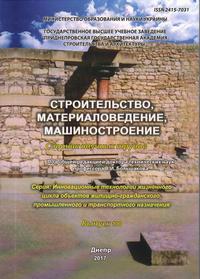Search for optimal parameters of fiber reinforced concrete plate on the elastic foundation
Keywords:
steel fibre reinforced concrete (SFRC), industrial floors, fiber reinforcement ratio, optimization, plate on the elastic foundationAbstract
Annotation. . Fibre reinforced concrete has been successfully used in Civil Engineering applications: such as industrial floors, roads, airports, pile supported floors, hydraulic structures, foundation slabs, architectural panels, precast products, shotcrete, structures in seismic regions etc. This composite material is one of the concrete of the new generation. It consists from concrete matrix and short randomly distributed fibres (steel, glass, various polymers and others.). But the strongest is steel fibre. fibre can be with curved ends or wavy for better anchoring in a concrete matrix. Fibre allows compensating such weakness of concrete as low growth resistance, high shrinkage cracking, low durability, etc. Steel fibre reinforced concrete (SFRC) has the ability of excellent tensile strength, flexural strength, shock resistance, fatigue resistance, ductility and crack arrest. So the steel fibre reinforced concrete (SFRC) is very efficient in comparison with conventional reinforced concrete. As a rule during the design SFRC industrial floor we face a problem: to determine necessary thickness of floor and fibre reinforcement ratio. However, according to national rules of design SFRC structures the main characteristics of materials depend on unknown thickness and fibre reinforcement ratio. Purpose. The purpose of the article is to develop optimal parameters algorithm for fiber reinforced concrete plate on the elastic foundation by known value of bending moment of the plate. Thickness of plate and fiber reinforcement ratio were considered as parameters. Methodology. Fiber reinforced concrete plate with ultimate bending moment 100 кН∙м was chosen for study. The formula for bending moment was transformed in such way that bending moment is a function. Findings. The diagram of the function is a surface. Each point on this surface is a possible solution of optimization problem. Equating the bending moment to maximal value and using the software Mathcad 14 we have received the line on the surface that is thickness/reinforcement ratio curve. Search for an optimum must be carrying out for the function of purpose which is the total cost of materials for 1 m2 of the floor. Originality. The new modified formula for bending moment was worked out. Thickness of plate and fiber reinforcement ratio were unknown in this formula. Practical value Proposed algorithm may be practiced during soft-ware engineering for optimization of SFRC floors.
References
Bolshakov V.I. Budivelne materialoznavstvo [Building materials science]. Dnipropetrovsk, 2004, 677 p.
DBN V.2.6-98:2009. Konsrtruktsiyi budynkiv i sporud. Betonni ta zalizobetonni konsrtruktsiyi. Osnovni polozhennya [Concrete and reinforced concrete structures], Kyiv, 2011. – 71 p.
DSTU-N B.V.2.6-78:2009. Konsrtruktsiyi budynkiv i sporud. Nastanova z proektuvannya ta vygotovlennya ctalefibrobetonnyh konstruktciy [Structures of buildings and erections. Instruction of application and production of fibre reinforced concrete construction], Kyiv, 2009. – 43 p.
Kovalenko O.V. Polimercementny fibrobeton – novy kompozytsiyny material dlya remontu ta rekonstruktsiyi gidrotehnichnyh sporud [Polymer-cement fibre reinforced concrete is the new composite material for repair and reconstruction of hydraulic structures]. Melioratsiya i vodne gospodarstvo [Amelioration and water equipment], 2011, Issue 99, P. 311-322.
Trofimovich V.V. Optimizatciya metallicheskih konstruktciy [Steel structural optimization] / Trofimovich V.V., Permyakov V.A., Kyiv, 1983. – 200 p.
Vikrant S. Vairagade. Introduction to Steel Fiber Reinforced Concrete on Engineering Performance of Concrete / Vikrant S. Vairagade, Kavita S. Kene // International Journal of Scientific & Technology Research. – 2012. – Vol. 1. – Issue 4. – P. 139 – 141.
Downloads
Published
Issue
Section
License
Редакція Видання категорично засуджує прояви плагіату в статтях та вживає всіх можливих заходів для його недопущення. Плагіат розглядається як форма порушення авторських прав і наукової етики.
При виявлені у статті більш ніж 25% запозиченого тексту без відповідних посилань та використання лапок, стаття кваліфікується як така, що містить плагіат. У цьому випадку стаття більше не розглядається редакцією, а автор отримує перше попередження.
Автори, в статтях яких повторно виявлено плагіат, не зможуть публікуватися в усіх журналах Видавництва ДВНЗ «Придніпровська державна академія будівництва та архітектури».
Автори, які публікуються у цьому журналі, погоджуються з наступними умовами:
- Автори залишають за собою право на авторство своєї роботи та передають журналу право першої публікації цієї роботи на умовах ліцензії Creative Commons Attribution License, котра дозволяє іншим особам вільно розповсюджувати опубліковану роботу з обов'язковим посиланням на авторів оригінальної роботи та першу публікацію роботи у цьому журналі.
- Автори мають право укладати самостійні додаткові угоди щодо неексклюзивного розповсюдження роботи у тому вигляді, в якому вона була опублікована цим журналом (наприклад, розміщувати роботу в електронному сховищі установи або публікувати у складі монографії), за умови збереження посилання на першу публікацію роботи у цьому журналі.
- Політика журналу дозволяє і заохочує розміщення авторами в мережі Інтернет (наприклад, у сховищах установ або на особистих веб-сайтах) рукопису роботи, як до подання цього рукопису до редакції, так і під час його редакційного опрацювання, оскільки це сприяє виникненню продуктивної наукової дискусії та позитивно позначається на оперативності та динаміці цитування опублікованої роботи (див. The Effect of Open Access).

